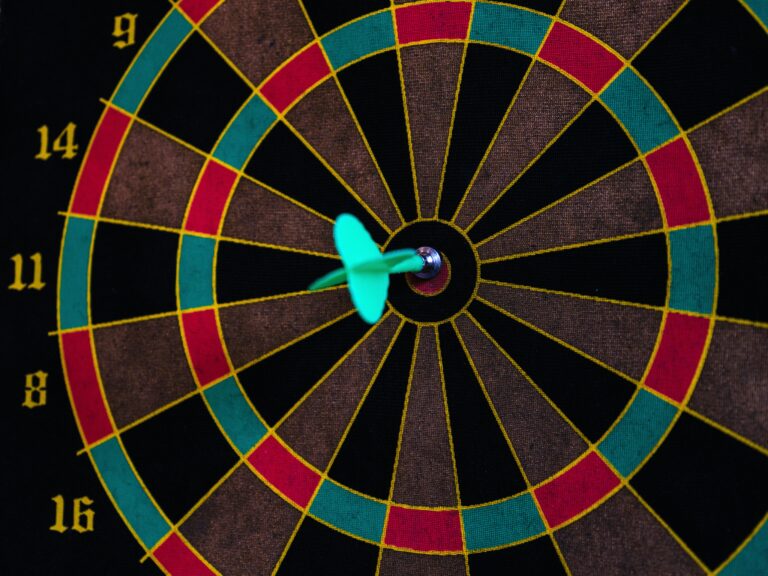Understanding Common Scoring Terms in Darts
It’s a coincidence you’re interested in darts just as you’re about to learn how important scoring terms are to the game. You’ll find that knowing what a treble, double, and bullseye mean can greatly change the way you approach each throw. Imagine tripling your points with a well-aimed treble or sealing a game with a precise double. But it’s not just about hitting the right segments; it’s about understanding how these terms fit into your overall strategy. So, what’s the significance of an outer bullseye or single segment values in shaping your game plan?
Key Takeaways
- Treble Segment: Scores three times the value of the segment are crucial for maximising points.
- Double Segment: Scores double the segment value and is vital for ending games like 501 or 301.
- Bullseye: centre of the board, divided into inner (50 points) and outer (25 points) sections, essential for high checkouts.
- Single Segment: Each segment ranges from 1 to 20 points, which is fundamental for planning and scoring.
- Outer Bullseye: Worth 25 points, provides strategic scoring opportunities and sets up finishing shots.
Treble (Triple)
Hitting the treble, or triple, ring on a dartboard scores you three times the number’s value. This outer ring of each number is vital for maximising your score. For example, landing a dart in the treble 20—often called the ‘bed’—earns you 60 points. It’s the highest-scoring segment on the board, making it a prime target for players aiming to finish a leg quickly.
When you hit the treble, you not only boost your points but also reduce the number of darts needed to reach your goal. This efficiency is essential in competitive play, where every dart counts. Aiming for the treble requires precision and skill, as missing it could mean hitting a lower-value segment or even missing the board entirely.
Players often practice hitting the treble to improve their accuracy and consistency. The treble 20, in particular, is a favourite target because of its high point value. By focusing on this segment, you can enhance your scoring potential significantly.
Mastering the treble is a key part of becoming a proficient dart player, and it’s a skill that can greatly influence the outcome of a match.
Double
In darts, the double ring is vital for both beginning and ending games, requiring players to demonstrate exceptional precision. This outer, narrow ring on the dartboard holds immense importance in games like 501 or 301, where you must hit a double to start scoring. It’s not just the start that demands your accuracy; finishing a game is equally dependent on hitting a double to bring your score precisely to zero.
Precision and accuracy are your best friends when aiming for doubles. These tiny targets can make or break your game, particularly in high-pressure situations of competitive matches. Hitting a double isn’t easy. The narrow ring leaves little room for error, meaning you need a steady hand and a sharp eye.
Strategically, mastering doubles can greatly elevate your dart-playing skills. Consistency is key. Practice hitting different doubles to improve your chances of closing out games efficiently.
Bullseye
At the heart of every dartboard lies the bullseye, a small yet essential target worth up to 50 points. It’s the centre point of the board and hitting it requires precision and accuracy. The bullseye is divided into two parts: the inner bullseye, which is green or red and worth 50 points, and the outer bullseye, which we’ll discuss later.
Mastering the bullseye can be a game-changer, especially when you’re aiming for high checkouts like the 170 finish. It’s not just about scoring, though. The bullseye often determines who starts the game or breaks ties in various dart games. So, knowing how to hit it consistently is critical.
When you’re aiming for the bullseye, you’re targeting a very small area. This makes it one of the most challenging spots on the dartboard. Hitting it demands focus and a steady hand. Practicing your aim on the bullseye can greatly improve your overall dart-playing skills.
Whether you’re a beginner or an experienced player, understanding the importance of the bullseye can enhance your game. It’s a key element that can turn the tide in your favour when it’s hit at the right moment.
Outer Bullseye
Between the inner bullseye and the single bull, the outer bullseye offers a valuable 25 points when struck. This area of the dartboard is essential for players aiming to score consistently. It can be particularly useful in setting up finishing shots, making it a key target for skilled players.
When you’re at the oche, aiming for the outer bullseye can help you reduce your remaining score strategically. Here are some reasons why the outer bullseye is significant:
- Scoring Consistency: Aiming for the outer bullseye can lead to more predictable scoring, which is beneficial during high-pressure moments.
- Setting Up Check-Outs: Hitting the outer bullseye can set you up nicely for a check-out, particularly when you need to finish on a double.
- Precision and Accuracy: Striking the outer bullseye demands a high level of precision, honing your skills and improving your overall performance.
- Strategic Advantage: Using the outer bullseye effectively can give you a strategic edge over your opponent, especially in close matches.
Single Segment Values
When you play darts, understanding the single-segment values is essential. Each segment on the dartboard has a specific point value, ranging from 1 to 20.
Knowing these values helps you strategize and aim for the points you need to win.
Basic Scoring System
Understanding the basic scoring system in darts is essential for any player aiming to master the game. Each segment on the dartboard has a specific value, making it important to know where to aim. The values range from 1 to 60, and hitting the right segments can greatly impact your score.
Here’s a quick breakdown of the scoring segments:
- Single Segment: The simplest scoring area. Each segment’s value is straightforward and ranges from 1 to 20.
- Double Ring: Located on the outer ring of the board. Hitting this area doubles the segment’s value.
- Triple Ring: Found in the middle ring section. Striking here triples the segment’s value.
- Bullseye: The centre of the board. The inner bullseye is worth 50 points, while the outer bullseye scores 25 points.
To excel, you need to reduce your total score to zero by aiming for specific segments. Knowing how each segment contributes to your score helps you strategize better, whether you’re playing casually or in a competitive setting. Mastering these basics will set you on the path to becoming a more proficient darts player.
Segment Point Values
Each segment on a standard dartboard has a specific point value that ranges from 1 to 20. This range is essential for understanding how to score in darts. When you hit the outer single ring of any segment, you earn the point value assigned to that segment. For example, hitting the outer single ring in the 20th segment earns you 20 points.
The outer ring, also known as the double ring, doubles the point value of the segment. So, if you hit the double ring in the 20th segment, you get 40 points. It’s a significant boost and can be a game-changer.
Likewise, the inner ring or bullseye, is another high-scoring area. The outer bull, which is part of the bullseye, is worth 25 points, while the inner bullseye netts you a solid 50 points.
Understanding these point values is vital for calculating your scores accurately. It also helps you aim for strategic combinations to achieve your desired total score.
Whether you’re a beginner or an experienced player, knowing these values will improve your game and help you make smarter choices during play.
Scoring Zones
When you’re aiming for high scores in darts, it’s important to understand the different scoring zones on the dartboard. The bullseye and outer bull are central targets, with the inner bull worth the most points.
Don’t forget about the triple and double rings, which can greatly boost your score when hit strategically.
Bullseye and Outer Bull
Have you ever wondered why hitting the bullseye or outer bull is so important in a game of darts? These scoring zones can make a huge difference in your game.
The bullseye, located right at the centre of the dartboard, is worth 50 points. The outer bull, also known as the bullseye ring, is worth 25 points.
Here are four key reasons why aiming for these areas is critical:
- High Scores: The bullseye offers the highest single-dart score on the board.
- Game Progression: Hitting these zones can significantly improve your total score, helping you finish the game quicker.
- Precision: Consistently hitting the bullseye requires skill, enhancing your overall accuracy.
- Game-Changer: In professional matches, every point matters. A bullseye or outer bull can be the deciding factor in a close game.
When you’re close to finishing the game, aiming for the bullseye or outer bull guarantees you can reach the required double to win. Precision and accuracy are key here.
Mastering the bullseye and outer bull zones can elevate your dart game, making you a formidable opponent. So next time, aim for that centre and watch your game transform!
Triple and Double Rings
Aiming for the triple and double rings can drastically boost your dart score. These scoring zones are essential for maximising points and efficiently finishing a game of darts. The triple ring is the outermost ring of a number segment and scores three times the value of that segment. So, if you hit the triple 20 (T20), you score a whopping 60 points, the highest possible with a single dart.
On the other hand, the double ring is the innermost ring of a number segment and scores double the value. This zone is vital when you’re trying to finish a game, as most dart formats require you to hit a double to win a leg.
Here’s a quick reference table to illustrate the scoring differences:
| Segment | Single Score | Double Score | Triple Score |
|---|---|---|---|
| 20 | 20 | 40 | 60 |
| 15 | 15 | 30 | 45 |
| 10 | 10 | 20 | 30 |
| 5 | 5 | 10 | 15 |
| 1 | 1 | 2 | 3 |
Mastering the triple and double rings not only enhances your scoring potential but also sharpens your aim, making you a formidable opponent on the dartboard. So, focus on these zones to up your game and finish strong.
Checkout Strategies
Mastering checkout strategies in darts means you’ll need to plan your final shots to hit a double or bullseye efficiently. This planning is essential because ending a leg with a precise hit can make or break your game. To guarantee you leave yourself on a preferred double or bullseye, consider these common checkout combinations based on your remaining score: double 16, double 8, or double 20.
Understanding the best checkout options will greatly enhance your performance. Here’s a quick guide to help you:
- Double 16: Often preferred because it breaks down into other useful doubles like double 8 if you miss.
- Double 20: A favourite for many since it’s at the top of the board, making it a clear target.
- Double 18: Offers flexibility as it splits into double 9.
- Bullseye: High-risk but can be a game-changer, especially if you’re running out of options.
Carefully planning your shots allows you to set up these preferred doubles, making your final darts more predictable and controlled. Effective checkout strategies can indeed be the difference between winning or losing a leg in a game of darts.
High-Scoring Tactics
To consistently rack up high scores in darts, you’ll need to aim for the treble segments, particularly focusing on the treble 20. Hitting the treble 20 three times with three darts gives you a perfect score of 180, the highest possible in a single turn. This might seem challenging, but it’s essential for maximising your scoring potential.
Another effective tactic is to aim for combination finishes. This requires precise placement of your darts across multiple segments to quickly reduce your remaining score. For instance, if you have 121 left to finish, you might aim for treble 20, single 11, and then bullseye. It’s all about planning ahead and ensuring you have a clear path to victory.
When you’re close to finishing a leg, focus on achieving a high check-out score. Strategically plan your final dart throws to end by hitting a double or bullseye. This not only secures the win but also demonstrates your precision and strategic thinking.
Lastly, practice grouping techniques. By landing your darts closely together on the board, you can consistently score high points. Grouping improves your accuracy and helps you maintain high scores throughout your game.
Conclusion
Mastering these common scoring terms in darts will greatly enhance your gameplay.
Did you know that hitting the treble 20 just three times in a turn netts you a whopping 180 points? It’s the highest score possible in a single round!
By understanding terms like treble, double, and bullseye, you’ll be better equipped to strategize and achieve higher scores.
So, keep practicing, and soon you’ll see a remarkable improvement in your dart game.







